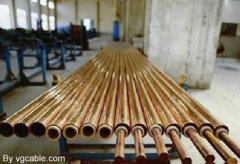BTTZ mineral insulated cable laying method and construction procedure

BTTZ mineral insulated cable construction preparation, measurement and positioning, bracket installation, bracket grounding, cable electrical insulation detection, insulation testing and other procedures construction and ordinary cable the same.
1. The construction of BTTZ mineral insulated cable is different from that of ordinary cable, mainly due to different construction technologies of cable line laying, intermediate joint and terminal joint.
2. Construction steps of BTTZ mineral insulated cable: construction preparation -- measurement and positioning -- bracket installation -- bracket grounding -- cable electrical insulation detection -- cable laying -- intermediate connector installation -- terminal connector installation -- insulation testing -- connecting equipment.
3. Mineral insulated cable laying:
4. Mineral insulated cable laying can be laid vertically or horizontally.
A. vertical laying of mineral insulated cable:
It can be laid from top to bottom. When laying, the construction personnel shall carry the cable to the highest place. If there is a rotating-plate wire setting frame, the cable can be placed on the rotating-plate, loosened and straightened while rotating, and slowly lowered along the vertical part. If there is no payoff frame, several auxiliary workers can hold the cable, slowly loosen and turn it (note: the whole cable should be turned together), and arrange it as it goes. In the whole laying line, one person should stand every 4 ~ 5 meters to help the cable lay down smoothly and keep the cable in place.
B. horizontal laying of mineral insulated cables:
Loosen the cable as above and gradually pull and put the cable along the horizontal direction, requiring one person to stand every 4-5 meters and keep the cable in place.
The following problems should be noted when laying cables:
1) when laying the cable, wood hammer or rubber hammer should be used to lay the cable in a straight line. The cable must not be twisted or knotted. When pulling the cable, do not drag the cable on the ground, rough wall or hard objects. Do not allow cables to be struck by sharp objects.
2) when laying at the same direction, the cable should be laid one by one from near to far according to the position of the fork of the cable, so as to avoid the influence of the cable crossing on the appearance.
3) after the cable is sawn off, the end shall be temporarily blocked to prevent moisture intrusion.
4) for large-section single-core cable, eddy current elimination measures should be taken when it is used for ac power grid. Under the action of alternating current, the copper sheath will form transverse eddy current, which can cause the loss of electric energy. When the line load is especially large and more than two sets of cables are needed, two or more sets of cables can be arranged as shown in figure 1. The distance between each set should be twice the outer diameter of the cables, and the wiring position of each set of cables should be the same to eliminate eddy current.
5) when the cable enters the distribution box and cabinet, it is necessary to punch holes in the plate surface of the box and cabinet to fix the cable, and also to prevent the cable from generating eddy current on the iron plate surface of the box and expansion. Holes should be cut on the surface of the box and cabinet as shown in figure 2, or the cable should be fixed with non-magnetic material spacer to prevent eddy current. If the box, cabinet no bottom plate, should consider the use of bracket fixed cable, this support a piece of aluminum, or copper plus production, drilling. When using flat steel or corner mace to make bracket, the hole should also refer to figure 1 to prevent the generation of eddy current.
6) after the same route is laid and the intermediate joint is made, the route should be arranged and fixed to meet the requirements of platoon construction. From top to bottom, from front to back, from beginning to end. At the bend, the cable shall be bent according to the specified bending radius. In order to be neat and beautiful, the direction of the whole cable (including the straight part and the curved part) should be all parallel direction, the bending radius of the bend should be consistent, the fixing points should be neat and the spacing should meet the requirements. If the cable is laid in the rack, it should also be all straight and neat. The bending is carried out according to the bending degree of the groove frame. Each cable should be bundled separately, if it can be fixed, it should also be fixed as required, if it cannot be fixed, it should be placed flat in the slot frame, but should not be piled up in a disorderly way. After finishing the arrangement, the cable nameplate shall be hung on both ends of each cable, and the cable model, specification, length, starting end, ending end and construction date shall be marked on the nameplate for reference.





